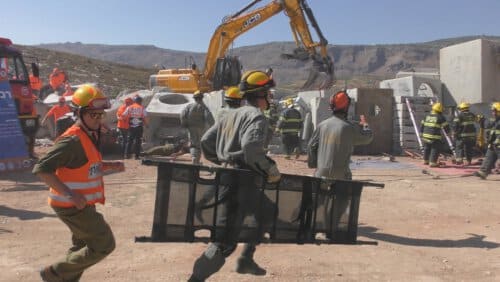The last earthquake with a magnitude of 6.5 on the Richter scale was felt in the Dead Sea valley in 1927, when hundreds of people were injured in Rabat Ammon, Jerusalem, Bethlehem and even Jaffa. Now, following the findings of the study, the researchers are warning that another earthquake may very likely happen in our lifetime, in the coming years or in the coming decades

A first study of its kind conducted at the bottom of the Dead Sea reveals that a devastating earthquake with a magnitude of 6.5 on the Richter scale is expected to hit our region in the coming years. According to the study, an earthquake of this magnitude occurs in the Land of Israel with an average cycle of between 130 and 150 years, but there have been cases in history where the gap between one earthquake and another was only a few decades.
The last earthquake with a magnitude of 6.5 on the Richter scale was felt in the Dead Sea valley in 1927, when hundreds of people were injured in Rabat Ammon, Jerusalem, Bethlehem and even Jaffa. Now, following the findings of the study, the researchers are warning that another earthquake may very likely happen in our lifetime, in the coming years or in the coming decades.
The research was conducted under the leadership of an international team of researchers, with the participation of Prof. Shmuel Marko, Head The Porter School of Environment and Earth Sciences at Tel Aviv University, and his fellow researchers from the School of Environment and Earth Sciences: Dr. Yen Lu, Prof. Amots Agnon, Dr. Nicholas Waldman, Dr. Nadav Wetzler and Dr. Glenn Biasi. The results of the groundbreaking research were published in the prestigious journal Science Advances.
As part of the research, the team of researchers was assisted by an international organization called ICDP, which carries out deep drilling in lakes all over the world, with the aim of studying the ancient climate of the earth and other changes that have occurred in the environment. In 2010, the rig was placed in the center of the Dead Sea and began to drill into the bottom, to a depth of hundreds of meters, allowing the analysis of approximately 220,000 years of geology of the Dead Sea - the longest record of its kind in the world.
Seasons in layers
According to Prof. Marko, since the Dead Sea is the lowest place on earth, every winter, the flood waters that flow into the Dead Sea carry with them silt, which accumulates at the bottom of the lake in different layers. A dark layer about a millimeter long that represents the winter drift and a light layer about a millimeter long that represents the increased evaporation of water during the summer, with each two such layers representing a different year.
At the same time, as soon as there is an earthquake, the sediments are stirred up, the layers that were previously deposited in a perfect arrangement are mixed and re-sedented in a different way. Using physical equations and computer models that the researchers developed specifically for this study, they were able to reconstruct from the geological record the history of earthquakes throughout the period.
The analysis of the findings shows that the frequency of earthquakes in the Dead Sea basin is not constant in time. There were periods of thousands of years with more tectonic activity and thousands of years with less tectonic activity. In addition, it became clear to the researchers that there was a significant underestimation of the frequency of earthquakes in Israel.
If until now researchers believed that the Dead Sea rift shakes with a magnitude of 7.5 on the Richter scale every 10,000 years on average - now it turns out that the deadly tremors are much more frequent, an average cycle ranging between 1,300 and 1,400 years. The researchers estimate that the last earthquake of such intensity hit us in 1,033 - that is, almost a thousand years ago. This means that in the next few hundred years, another earthquake on a scale of 7.5 and above is expected.
On the other hand, the aforementioned researchers found that earthquakes with a magnitude of 6.5 do occur in our region on average every 130 to 150 years, but the frequency between the earthquakes varies, and while there were cases where the gaps between one earthquake and another were hundreds of years, there were also cases in which powerful earthquakes occurred Only a few decades apart.
"I don't want to scare you," Prof. Marko concludes, "but we live in a tectonically active period. The geological record does not lie, and a big earthquake in Israel is coming. Of course, we have no way of predicting exactly when the earth will shake under our feet - this is a statistical forecast - but unfortunately I can say that an earthquake that will cause hundreds of casualties will happen in the next few years, it could be in ten years or decades, but it could also be next week and we have to prepare for it.
More of the topic in Hayadan:
